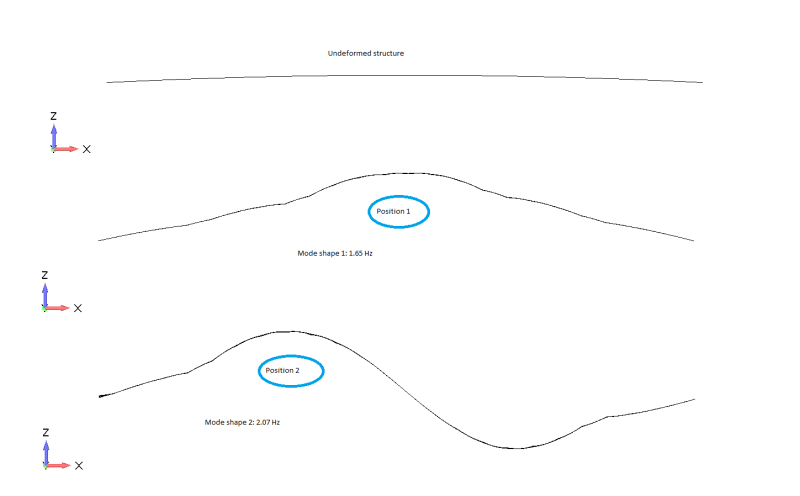Hi all
I have a project that involves the dynamic design of a slender beam. The structure is a pedestrian bridge and the span is ~ 90 m. In the figures below I have limited the geometry to the walkway.
The issue is that the vertical acceleration for the first mode shape has been to high for a while. Now there has been changes so the second mode shape is also in trouble.
I have assumed a damping of 1 % (of critical) and the idea was to use a TMD damper if the vibrations proved to be to high for the walkway. The vibrations will be measured after the bridge is completed. One option was originally, for practical reasons, to use two dampers at the same position (Position 1).That would be optimal for the performance of the TMD. Now since Mode 2 may also need some reduction my idea is to move one of the dampers towards position 2. The hope is that it will reduce the acceleration level for mode 2. I basically need to reduce the vibration level for mode 1 to half the original and mode 2 to 70 % of the original. I don't think I need optimal performance from the TMD. Just "good enough"![[smile] [smile] [smile]](/data/assets/smilies/smile.gif)
I have worked with dynamics on and of for years and occasionally had TMD'sd as possible solutions. But this situation is now for me. I will of course discuss it with the person that designs the TMD but for now, am I completely off here? Does anybody have experience from TMD's?
Best regards
Thomas

I have a project that involves the dynamic design of a slender beam. The structure is a pedestrian bridge and the span is ~ 90 m. In the figures below I have limited the geometry to the walkway.
The issue is that the vertical acceleration for the first mode shape has been to high for a while. Now there has been changes so the second mode shape is also in trouble.
I have assumed a damping of 1 % (of critical) and the idea was to use a TMD damper if the vibrations proved to be to high for the walkway. The vibrations will be measured after the bridge is completed. One option was originally, for practical reasons, to use two dampers at the same position (Position 1).That would be optimal for the performance of the TMD. Now since Mode 2 may also need some reduction my idea is to move one of the dampers towards position 2. The hope is that it will reduce the acceleration level for mode 2. I basically need to reduce the vibration level for mode 1 to half the original and mode 2 to 70 % of the original. I don't think I need optimal performance from the TMD. Just "good enough"
![[smile] [smile] [smile]](/data/assets/smilies/smile.gif)
I have worked with dynamics on and of for years and occasionally had TMD'sd as possible solutions. But this situation is now for me. I will of course discuss it with the person that designs the TMD but for now, am I completely off here? Does anybody have experience from TMD's?
Best regards
Thomas

